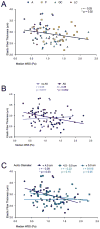Aortic valve-mediated wall shear stress is heterogeneous and predicts regional aortic elastic fiber thinning in bicuspid aortic valve-associated aortopathy
- PMID: 30060930
- PMCID: PMC6242768
- DOI: 10.1016/j.jtcvs.2018.05.095
Aortic valve-mediated wall shear stress is heterogeneous and predicts regional aortic elastic fiber thinning in bicuspid aortic valve-associated aortopathy
Abstract
Objectives: The objectives of this study were to investigate an association between the magnitude of flow-mediated aortic wall shear stress (WSS) and medial wall histopathology in patients with bicuspid aortic valve (BAV) with aortopathy.
Methods: Patients with BAV (n = 27; 52 ± 15 years; 3 women; proximal thoracic aorta diameter = 4.4 ± 0.7 and 4.6 ± 0.5 cm) who underwent prophylactic aortic resection received preoperative 3-dimensional time-resolved phase-contrast magnetic resonance imaging with 3-dimensional velocity encoding to quantify WSS relative to a population of healthy age- and sex-matched tricuspid aortic valve control participants (n = 20). Quantitative histopathology was conducted on BAV aorta tissue samples resected at surgery (n = 93), and correlation was performed between elastic fiber thickness and in vivo aortic WSS as continuous variables. Validation of elastic fiber thickness was achieved by correlation relative to tissue stiffness determined using biaxial biomechanical testing (n = 22 samples).
Results: Elastic fibers were thinner and WSS was higher along the greater curvature compared with other circumferential regions (vs anterior wall: P = .003 and P = .0001, respectively; lesser curvature: both P = .001). Increased regional WSS was associated with decreased elastic fiber thickness (r = -0.25; P = .02). Patient stratification with subanalysis showed an increase in the correlation between WSS and histopathology with aortic valve stenosis (r = -0.36; P = .002) and smaller aortic diameters (<4.5 cm: r = -0.39; P = .03). Elastic fiber thinning was associated with circumferential stiffness (r = -0.41; P = .06).
Conclusions: For patients with BAV, increased aortic valve-mediated WSS is significantly associated with elastic fiber thinning, particularly with aortic valve stenosis and in earlier stages of aortopathy. Elastic fiber thinning correlates with impaired tissue biomechanics. These novel findings further implicate valve-mediated hemodynamics in the progression of BAV aortopathy.
Keywords: 4D flow MRI; aortopathy; bicuspid aortic valve; wall shear stress.
Copyright © 2018 The American Association for Thoracic Surgery. Published by Elsevier Inc. All rights reserved.
Conflict of interest statement
The authors have no conflict of interest to disclose.
Figures






Comment in
-
You can never step twice in the same river.J Thorac Cardiovasc Surg. 2018 Dec;156(6):2121-2122. doi: 10.1016/j.jtcvs.2018.06.024. Epub 2018 Jul 3. J Thorac Cardiovasc Surg. 2018. PMID: 30037772 No abstract available.
-
Personalized cardiac surgery: Can noninvasive flow imaging lead to individualized resection strategies for bicuspid aortopathy?J Thorac Cardiovasc Surg. 2018 Dec;156(6):2110-2111. doi: 10.1016/j.jtcvs.2018.06.060. Epub 2018 Jul 19. J Thorac Cardiovasc Surg. 2018. PMID: 30107927 No abstract available.
-
We somehow imagined it, now we know! What an opportunity!J Thorac Cardiovasc Surg. 2018 Dec;156(6):2123. doi: 10.1016/j.jtcvs.2018.07.010. Epub 2018 Jul 20. J Thorac Cardiovasc Surg. 2018. PMID: 30143381 No abstract available.
References
-
- Fedak PWM, Verma S, David TE, Leask RL, Weisel RD, Butany J. Clinical and pathophysiological implications of a bicuspid aortic valve. Circulation. 2002;106(8):900–4. - PubMed
-
- Fedak PWM. Bicuspid aortic valve and the specialty clinic: are your patients at risk? Cardiol Young. 2017 Apr 6;27(3):411–2. - PubMed
-
- Verma S, Yanagawa B, Kalra S, Ruel M, Peterson MD, Yamashita MH, et al. Knowledge, attitudes, and practice patterns in surgical management of bicuspid aortopathy: a survey of 100 cardiac surgeons. J Thorac Cardiovasc Surg. 2013;146(5):1033–1040 e4. - PubMed
-
- Hardikar AA, Marwick TH. The natural history of guidelines: The case of aortopathy related to bicuspid aortic valves. Int J Cardiol. 2015;199:150–3. - PubMed
Publication types
MeSH terms
Grants and funding
LinkOut - more resources
Full Text Sources
Other Literature Sources
Medical
Research Materials

